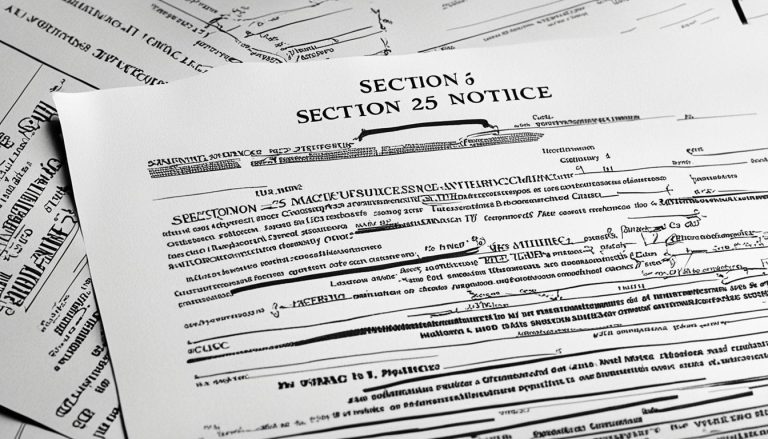Understanding the ins and outs of renting can be daunting, especially when it comes to legal notices like a Section 8 notice. This document plays a crucial role in the landlord-tenant relationship, particularly when disputes arise over tenancy agreements. Whether you’re a landlord needing to reclaim your property or a tenant facing eviction, knowing what a Section 8 notice entails is essential. Let’s delve into its purpose and significance in the rental landscape.
What is a Section 8 Notice?

A Section 8 notice is a legal document used by landlords in England and Wales to terminate assured tenancies. It outlines the grounds for seeking possession of the property, which can be mandatory or discretionary.
The notice must clearly state the reasons for eviction, allowing tenants to understand their situation. This process ensures that both parties are aware of their rights and responsibilities under tenancy law.
Mandatory Grounds for Possession

Mandatory grounds for possession are specific reasons that allow landlords to regain their property without much delay. These grounds include situations like owner occupation, repossession by lenders, and other predefined scenarios.
Landlords must prove these mandatory conditions in court. If established, the judge typically has no discretion and is required to grant possession of the property back to the landlord promptly.
Ground 1
Ground 1 allows landlords to regain possession of their property if they intend to occupy it themselves. This ground requires prior notice, ensuring tenants are informed well in advance.
Landlords must demonstrate a genuine need for the property. If successful, this ground provides an essential means for owners needing their home back after renting it out. It emphasizes the importance of clear communication and proper notification processes.
Ground 2
Ground 2 allows a landlord to reclaim possession of the property when repossession is initiated by their mortgage lender. This situation typically arises if the landlord has defaulted on mortgage payments, leading lenders to take legal action.
When serving a Section 8 Notice under this ground, landlords must provide evidence of the lender’s involvement and follow specific protocols set by law. It’s essential for landlords to act promptly in such cases.
Ground 3
Ground 3 refers to situations where a property is let out as a holiday accommodation but is not booked for an extended period. This ground allows landlords to regain possession when the rental season ends, and no reservations are in place.
Landlords can assert this claim if they intend to reoccupy the property themselves or make it available for holiday guests again. It provides flexibility essential in seasonal rental markets.
Ground 4
Ground 4 allows landlords to regain possession of a property let to students if it’s owned by an educational institution. This ground is specifically designed for cases where the tenancy relates closely to the academic calendar.
If the landlord intends to use the property for educational purposes, they can serve a Section 8 notice. The focus here is on ensuring that housing aligns with student needs and institutional requirements.
Ground 5
Ground 5 allows landlords to regain possession of their property when a minister of religion is involved. This applies specifically when the tenant occupies a dwelling tied to their role in religious activities.
If the housing is provided for religious duties, it ensures that both the landlord and community can fulfill their commitments without disruption. This ground recognizes the unique nature of living arrangements associated with spiritual leadership.
Ground 6
Ground 6 allows landlords to regain possession of a property for redevelopment purposes. This often involves significant alterations or rebuilding that necessitate vacant possession.
Landlords must demonstrate genuine intent to improve the property substantially. Proper documentation, including planning permissions, is crucial when pursuing this ground for eviction. Tenants should be informed about the proposed changes and given adequate time to vacate the premises.
Ground 7
Ground 7 refers to the situation where an assured tenant has passed away. This ground allows landlords to regain possession of the property without needing further justification, as the tenancy cannot continue after a tenant’s death.
In such cases, it’s essential for landlords to provide appropriate documentation, like a death certificate, when serving a Section 8 notice. This ensures that the legal process is followed correctly and minimizes potential disputes.
Ground 7A
Ground 7A relates to instances of anti-social behaviour by a tenant or their guests. This can include actions that disrupt the peace, such as excessive noise, harassment of neighbors, or vandalism.
Landlords must gather evidence to support this claim. Documented incidents and witness testimonies are essential in establishing a pattern of disruptive behavior that justifies seeking possession through a Section 8 notice.
Ground 7B
Ground 7B applies when a tenant does not have the legal right to rent in the UK. This situation typically arises if their immigration status changes or they fail to provide sufficient documentation proving their eligibility.
Landlords can use this ground for possession, highlighting that renting without the right is unlawful. It ensures compliance with regulations and protects landlords from potential penalties associated with illegal tenancies.
Ground 8
Ground 8 refers to serious rent arrears and is a mandatory ground for possession under Section 8. A landlord can seek eviction if the tenant owes eight weeks’ rent or more at the time of serving notice.
This ground emphasizes that landlords have a right to recover their property when tenants fail significantly in their rental obligations. It ensures that timely payments are prioritized, maintaining the integrity of rental agreements.
Discretionary Grounds for Possession

Discretionary grounds for possession allow landlords to seek eviction based on specific circumstances. These include issues like persistent late rent payments, breach of the tenancy agreement unrelated to rent, and property deterioration due to tenant actions.
Other grounds involve nuisance or annoyance caused by tenants, domestic violence situations, and damage to furniture. Each case is evaluated individually in court, offering a more flexible approach compared to mandatory grounds.
Ground 9
Ground 9 refers to the landlord’s obligation to offer suitable alternative accommodation to tenants facing eviction. This ground ensures that tenants are not left without housing, promoting fairness in the eviction process.
The alternative accommodation must meet specific criteria, such as being adequate and available for immediate occupation. Landlords need to provide clear details about this option during the possession proceedings for it to be considered valid.
Ground 10
Ground 10 relates to rent arrears, allowing landlords to seek possession when tenants fall behind on their payments. If a tenant has at least two months’ unpaid rent at the time of serving the notice, this ground becomes applicable.
Landlords must provide evidence of outstanding amounts. A court may grant possession if it’s proven that the tenant is consistently in arrears. This ground emphasizes financial responsibility within rental agreements.
Ground 11
Ground 11 refers to the situation where a tenant consistently pays rent late. This can create financial uncertainty for landlords, making it difficult to manage cash flow and meet mortgage obligations.
If a tenant has repeatedly failed to pay on time, landlords may use this ground in a Section 8 notice. Proper documentation of late payments is crucial for supporting any claim made under this ground during possession proceedings.
Ground 12
Ground 12 applies when a tenant breaches their tenancy agreement in ways that do not involve rent. This could include issues like unauthorized subletting or causing significant damage to the property.
Landlords must provide evidence of the breach and demonstrate how it impacts the tenancy. If proven, this ground can support an eviction claim under a Section 8 notice, allowing landlords to regain possession of their property effectively.
Ground 13
Ground 13 refers to property deterioration caused by a tenant’s actions or neglect. This can include significant damage to the property, such as broken fixtures, stained carpets, or unclean living conditions.
Landlords may use this ground for possession if they can prove that the tenant’s behavior has led to a decline in the property’s state. Evidence of neglect is crucial in these cases for successful eviction proceedings.
Ground 14
Ground 14 addresses situations where a tenant causes nuisance or annoyance to neighbors. This could include loud parties, harassment, or other disruptive behaviors. Such actions can significantly affect the quality of life of those living nearby.
Additionally, this ground covers illegal or immoral use of the property. Examples might involve drug-related activities or engaging in prostitution. Landlords can pursue possession if these serious breaches occur, ensuring a safer community for everyone.
Ground 14A
Ground 14A allows landlords to seek possession if a tenant has been involved in domestic violence. This provision recognizes the serious impact of such situations on victims, enabling swift action to ensure their safety.
The law provides a pathway for landlords when an assured tenant is found guilty of violent behavior against another individual residing within the property. It’s crucial for landlords to approach these cases with sensitivity and care.
Ground 14ZA
Ground 14ZA refers to a situation where a tenant has been convicted of a riot offence. This ground allows landlords to seek possession of the property due to serious disturbances that can impact other residents and community safety.
A conviction for such an offence typically indicates behavior that disrupts peace and order. Landlords may pursue eviction under this ground, aiming to maintain a safe living environment for all tenants.
Ground 15
Ground 15 pertains to damage caused to furniture within the rental property. If a tenant intentionally damages or neglects furnishings provided by the landlord, it can lead to eviction proceedings.
Landlords must document and prove the extent of damage. This includes photographs and repair estimates. Clear evidence supports the claim when seeking possession through a Section 8 notice. Understanding this ground is essential for both landlords and tenants navigating disputes effectively.
Ground 16
Ground 16 refers to situations where a tenant is a former employee of the landlord. This ground can be used if the tenancy was granted as part of their employment agreement. If that employment ends, landlords may seek possession based on this criterion.
This provision allows landlords to reclaim properties when they no longer have a valid reason for keeping former employees as tenants. It helps protect landlord interests in specific circumstances.
Ground 17
Ground 17 involves tenants making false statements during the tenancy application process. If a landlord discovers that a tenant misrepresented their circumstances, they may use this ground for eviction.
Such dishonesty can include providing incorrect information about income, identity, or rental history. Landlords must provide evidence of the false statement to support their claim in court effectively. This ground protects landlords from deceitful practices and upholds honest renting standards.
How to Serve a Section 8 Notice?
Serving a Section 8 notice is an important step for landlords in the UK who wish to begin eviction proceedings against tenants for specific breaches of their tenancy agreement. Here’s a detailed guide on how to serve a Section 8 notice:
Understand the Grounds for Eviction
Section 8 notices are used when the landlord wants to evict a tenant because of a breach of the tenancy agreement. Common grounds include:
- Rent arrears (Ground 8, 10, or 11)
- Anti-social behavior (Ground 14)
- The property is no longer suitable for the tenant (Ground 13)
- Breach of any tenancy obligation.
Choose the Correct Form
A Section 8 notice is officially known as Form 3. Make sure that you use the correct version of the form, which should specify the grounds for possession that apply to your situation.
Complete the Notice Accurately
- Fill out the form with the necessary information:
- Details of the landlord and tenant.
- The address of the property.
- The specific ground(s) for possession.
- The date by which the tenant must vacate (this must adhere to the notice period required for the grounds being cited).
Determine the Notice Period
- The notice period varies based on the grounds for possession:
- For serious breaches like rent arrears (Ground 8), it can be 2 weeks.
- For other grounds, it may range from 2 weeks to 2 months. Be sure to check the specific requirements for the grounds you’re using.
Serve the Notice Properly
You can serve the Section 8 notice in several ways:
- In-person: Hand it directly to the tenant.
- By post: Send it through first-class mail to the tenant’s last known address.
- Email: If the tenant has agreed to receive documents electronically, you may send it via email.
Keep a Record
Maintain a copy of the notice and any evidence of how and when it was served. This could include a signed delivery receipt if served in person, or a proof of postage if sent by mail.
Wait for the Response
Once served, the tenant has the opportunity to respond to the notice. They may either comply by vacating the property or contest the notice.
Proceed with Possession Action
If the tenant does not leave by the end of the notice period, you can apply to the court for possession. Make sure to provide all necessary documentation, including proof of the served notice.
Additional Considerations
- Seek Legal Advice: If you’re unsure about any part of the process or the grounds for eviction, consider consulting a legal professional or a housing advisor.
- Consider Mediation: Sometimes, disputes can be resolved through mediation without the need for formal eviction proceedings.
By following these steps, you can ensure that the Section 8 notice is served correctly and that you adhere to legal requirements throughout the process.
Important Factors of Section 8 Evictions

Section 8 evictions are governed by specific legal guidelines. It’s essential for landlords to follow the correct procedures to avoid complications or delays in possession claims.
Tenants have rights, and they can challenge the notice if it’s improperly served. Understanding these factors helps landlords navigate potential disputes effectively while ensuring compliance with housing regulations. Proper documentation and timing are crucial in this process.
How Long Does a Section 8 Notice Take?
A Section 8 notice typically requires a minimum of two weeks’ notice before the landlord can proceed with eviction. This timeframe allows tenants to address any issues or prepare for potential court proceedings.
However, this duration may vary based on specific grounds for possession. Some cases might necessitate longer notices, especially if significant arrears or serious breaches are involved. Understanding these timelines is crucial for both landlords and tenants alike.
When Can a Section 8 Notice Be Issued?

A Section 8 notice can be issued when a tenant has breached their tenancy agreement. This includes non-payment of rent or causing damage to the property.
Landlords may also serve this notice for reasons like anti-social behavior or if they require the property for personal use. It’s essential to follow the correct procedure and provide adequate grounds for issuing the notice to ensure compliance with housing laws.
Conclusion
Understanding what a Section 8 notice entails is crucial for both landlords and tenants. It serves as an essential tool in the eviction process, particularly when specific grounds for possession are met. By being informed about mandatory and discretionary grounds, landlords can take appropriate action while ensuring they comply with legal requirements.
For tenants, knowing their rights helps them respond effectively if served with such a notice. Always remember that proper procedure matters greatly in these situations. Whether you’re facing eviction or seeking to regain your property, navigating this process thoughtfully will aid in achieving fair outcomes for all parties involved.
FAQ
What happens if a tenant does not vacate after receiving a Section 8 notice?
If a tenant does not leave the property after the notice period, the landlord may need to apply for a possession order through the court system to regain possession formally.
What should landlords include in a Section 8 notice?
Landlords should include details about the tenant and tenancy, clearly state the grounds for possession, and provide any necessary supporting documentation, such as evidence of rent arrears or breach of tenancy.
Can tenants challenge a Section 8 notice?
Yes, tenants can challenge a Section 8 notice if they believe it was improperly served or if the claimed grounds for possession are not valid. Legal advice may be beneficial in these situations.
How important is proper documentation in the Section 8 process?
Proper documentation is crucial for both landlords and tenants to avoid disputes and ensure the legal process is followed correctly. Any errors or omissions can cause delays or invalidate the notice.
What are the rights of tenants when served with a Section 8 notice?
Tenants have the right to understand the reasons behind the notice, respond to it, seek legal advice, and potentially challenge its validity in court if they believe it was issued unfairly.






